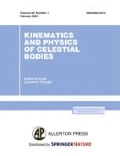Abstract
From October 7, 2012, to January 28, 2017 (GPS weeks 1709–1933) all products of the International GNSS Service (IGS)—precise ephemerides of GPS and GLONASS satellites, coordinates and velocities of permanent GNSS stations, etc.—were based on the IGb08 reference frame, the updated IGS realization of the release of the International Terrestrial Reference Frame (ITRF2008). Observations of GNSS satellites at permanent stations located in Ukraine and in Eastern Europe for this period were processed in the GNSS Data Analysis Centre of the Main Astronomical Observatory of the National Academy of Sciences of Ukraine. The processing was carried out with Bernese GNSS Software ver. 5.2 according to the requirements of the European Permanent GNSS Network (EPN) that were valid at that time. In total, observations on 232 GNSS stations, including 201 Ukrainian stations belonging to the following operators of GNSS networks were processed: MAO NAS of Ukraine, Research Institute of Geodesy and Cartography, NU Lviv Polytechnic (GeoTerrace), PJSC System Solutions (System.NET), TNT TPI company (TNT TPI GNSS Network), Navigation Geodetic Center Ltd. (NGC.net), UA-EUPOS/ZAKPOS, Europromservice Ltd. (EPS), Coordinate Navigation Maintenance System of Ukraine (CNMSU), and Kharkiv National University of Radio Electronics. The IGb08 reference frame was set by No-Net-Translation conditions on the coordinates of the IGS Reference Frame stations. As result, the stations’ coordinates in the IGb08 reference frame and the zenith tropospheric delays for all stations were estimated. The mean repeatabilities for components of stations’ coordinates for all weeks (the characteristics of the precision of the received daily and weekly solutions) are in the following ranges: for north and east components—from 0.5 mm to 1.6 mm (average values are 0.99 mm and 1.01 mm respectively), for hight component—from 2.2 mm to 5.4 mm (average value is 3.75 mm) with an outlier of 6.91 mm for GPS week 1759.





Similar content being viewed by others
REFERENCES
O. A. Khoda, “GPS data analysis center of the main astronomical observatory: Results of observation processing for GPS weeks 1236–1399,” Kinematics Phys. Celestial Bodies 26, 313–321 (2010). https://doi.org/10.3103/S0884591310060036
O. A. Khoda, “Measurement of coordinates of Ukrainian permanent GPS stations from observation data for GPS weeks 1236–1399,” Kinematics Phys. Celestial Bodies 27, 17–29 (2011). https://doi.org/10.3103/S088459131101003X
O. Khoda, “Determination of zenith tropospheric path delay for the Ukrainian permanent GPS stations using observation data for GPS weeks 1236–1399,” Kinematics Phys. Celestial Bodies 27, 59–61 (2011). https://doi.org/10.3103/S088459131102005X
O. A. Khoda, “GNSS Data Analysis Centre of the Main Astronomical Observatory NAS of Ukraine: Results of observations processing for GPS weeks 1400–1631,” Kosm. Nauka Tekhnol. 21, 56–64 (2015).
O. A. Khoda, “Estimation of coordinates of the Eastern European permanent GNSS stations using observation data for GPS weeks 1632–1708,” Kosm. Nauka Tekhnol. 21, 56–65 (2015).
Bernese GNSS Software Version 5.2, Ed. by R. Dach, S. Lutz, P. Walser, and P. Fridez (Univ. of Berne, Berne, 2015). https://doi.org/10.7892/boris.72297
IERS Conventions (2010), Ed. by G. Petit and B. Luzum, IERS Technical Note No. 36 (Verlag des Bundesamts für Kartographie und Geodäsie, Frankfurt am Main, 2010).
I. Nassi and B. Shneiderman, “Flowchart techniques for structured programming,” ACM Sigplan Not. 8 (8), 12–26 (1973). https://doi.org/10.1145/953349.953350
P. Rebischung, “IGb08: An update on IGS08,” IGSMAIL–6663 (2012). https://lists.igs.org/pipermail/igsmail/ 2012/000497.html.
R. Schmid, “Igs08_1707.atx: Update including JPSREGANT subtype calibrations & R743,” IGSMAIL–6662 (2012). https://lists.igs.org/pipermail/igsmail/2012/000496.html.
Author information
Authors and Affiliations
Corresponding author
Additional information
The article was translated by the author.
About this article
Cite this article
Khoda, O. Estimation of Coordinates of the Eastern European Permanent GNSS Stations in the IGb08 Reference Frame for GPS Weeks 1709–1933. Kinemat. Phys. Celest. Bodies 35, 46–53 (2019). https://doi.org/10.3103/S0884591319010045
Received:
Revised:
Accepted:
Published:
Issue Date:
DOI: https://doi.org/10.3103/S0884591319010045




